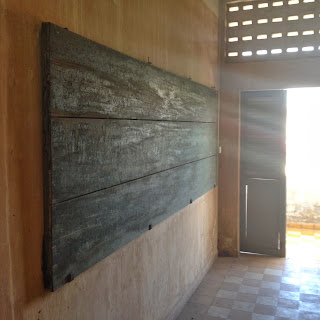A Torture room at Tuol Sleng Prison. The picture on the wall is of one of the victims, found dead and decomposing after the Khmer Rouge fled the city in 1979.
A black board in one of the cells, a remnant from when these were classrooms.
Barbed wire strung across the upper floors to prevent prisoners leaping to their deaths to end the suffering
I set out early this morning, walking West and South from the Phenom Penh riverside. My destination was the Tuol Sleng prison and torture center, established by the Khmer Rouge in 1975 after they had expelled virtually the entire population of the city. People were forced out of most of the cities and towns of Cambodia, settled in communal camps, and put to forced labour. Pol Pot and his henchmen took a former primary and high school, an innocuous compound of four large, boring three story concrete structures, and turned them into a horrific torture center. About 20,000 people entered this place. They were tortured until they confessed to whatever they were accused of and then they were taken to the Killing Fields and bludgeoned to death. Of those 20,000 persons, about 130 survived to tell the tale. Each of those persons who entered the gates of Tuol Sleng, or Office S-21 as it was called, were meticulously photographed and their height and weight recorded. Many, many of the photographs of the victims survived as the Khmer Rouge fled the invading Vietnamese Army in 1979. The torturers themselves left the most accurate and chilling documentation of their crimes.
The bare concrete rooms were converted to cells, some for solitary confinement and some with the doomed prisoners shackled in lines. Many prisoners were chained to bare iron bed frames. What I saw were stark concrete rooms, iron bed frames, and window shutters paneled with glass to deaden the screams that could be heard from outside the walls. Not that the Khmer Rouge thugs really cared who heard.
Other rooms contained nothing but rows and rows of photographs of the victims, each holding or wearing a number to identify them. The faces in these photographs looked into the camera with a heart-rending range of expressions. Fear of course, resignation, defeat, but also, occasionally, defiance and strength. There were even some smiles on these faces, as if to ward off the terror. These images were, and are, so powerful as to make description impossible. As I walked by row after row of these human faces, each set of eyes looking directly out at the camera, one woman's face locked my steps. Those eyes, that face, long dead, are burned into my heart. I was overwhelmed by the untouchable sadness and strength that I saw portrayed in her photograph. Her image will haunt me.
As I moved further into the compound, from building to building and floor to floor, it grew much worse. There are displays of the implements of torture; the drowning tanks, racks for holding victims while their fingernails were pulled out, bludgeons and whips of electrical cord. And there are the skulls, racks of skulls and clear boxes of bones.
For all of the horror of Tuol Sleng, the banality of the actual setting is perhaps the worst. Four plain concrete buildings, a courtyard, a fence. It is a small place, yet the barbarity that took place here is enormous.
I would very much like to be able to tell you that the murderous bastards that killed all of these people have been brought to justice, but I cannot. After 1979, the Khmer Rouge had fled Phenom Penh, no longer ruling the country. They did, however, remain powerful in many parts of the countryside, particularly along the Thai border, where they enriched themselves with the plunder of timber and precious gems. They sold these resources to Thai generals across the border. In their jungle enclaves they remained until the late 1990's. Many former KR soldiers simply went back to their villages, living alongside those that they had forced to labour, that they had starved and killed.
Pol Pot died rich and fat in his mansion in Northern Cambodia. Beginning in the first decade of this new millennium, a special Tribunal was formed to prosecute the heads of the Khmer Rouge. Several of the leaders of the KR, including the head henchman of Tuol Sleng, Comrade Duch, have been indicted. At the rate the Tribunal is moving, most of these murderers will die of natural causes before suffering any judicial consequences for their heinous actions.
What I will take away from Tuol Sleng is that same lesson learned in other places of atrocities. Human beings have within themselves an incredible capacity for inflicting cruelty on their fellow human beings and human beings have within themselves an unbelievable capacity for suffering that cruelty.
And willingly or not, I will take away the face of that woman in the photograph.



No comments:
Post a Comment